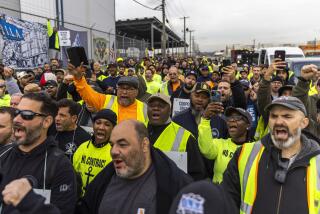UPS Now Faces Job of Delivering Reassurance
- Share via
United Parcel Service’s deep financial resources helped it weather the Teamsters’ 15-day strike, but the nation’s largest shipping company now faces new challenges: restoring worker goodwill and regaining business from newly skeptical customers.
Getting its operations back in gear and moving backlogged packages shouldn’t take long. With a tentative settlement in hand, workers are expected back on the job by midweek.
In its favor, the company has deep pockets and good credit, and still has a strong, skilled work force. The company could offer price cuts and other incentives to bring back business from unhappy customers.
But restoring the morale of its enormous work force of 338,000 worldwide--especially the 185,000 domestic workers represented by the Teamsters--will be key, business experts say. The company’s family image and the goodwill of its cheerful drivers who often were revered by customers have been central to the company’s past success in gaining an overwhelming share of the nation’s package-delivery business.
Emotions could be frayed by resentment against workers who crossed picket lines. Some picketers said Monday night that the two-week walkout has created hard feelings between workers and their supervisors.
Beyond that, the most challenging long-term issue may be in restoring the full confidence of customers.
*
When the strike began, the company had 1.2 million permanent clients for which it made daily deliveries. UPS must bring what it acknowledged is an “uncalculated” number of those businesses back to its fold--disgruntled enterprises that were forced to quickly find other means of shipping when the strike hit.
Certainly many companies found other ways for moving goods--the U.S. Postal Service, trucking firms, couriers and mail-service companies. And some said they might continue to make use of those alternatives when the strike ends.
“We will establish alternatives because we are in fear this will happen again,” Vera Campbell, owner of junior sportswear maker Knit Works in Los Angeles, said Monday night after hearing of the settlement. “We don’t want to be in bed with one person.”
But Campbell acknowledged that alternative shippers that hauled Knit Works’ clothes to retailers for back-to-school promotions had started taking fewer and fewer boxes because they were overwhelmed.
Irvine-based TNR Technical Inc. found a new way to ship batteries. “We found out you could put five boxes of 40 pounds each on a pallet and ship them together by truck,” said Matthew Hoscoe. “It takes longer, but you can do it.”
Indeed, many businesses vowed never to entrust all of their deliveries to UPS again, although analysts have forecast that most will eventually drift back to UPS once the company’s workers return. The main reason: UPS’ route system simply dwarfs nearly all others. It’s also cheaper than all but a few alternatives.
“Most of the volume is going to come back,” predicted Martine Nowicki, a credit analyst at Moody’s Investors Service in New York.
Even so, UPS has an immense public relations effort ahead to restore its former image as the utterly dependable “Big Brown,” with cheerful employees driving its box-like trucks and a spit-polished organization that made it, in UPS’ own words, “the tightest ship in the shipping business.”
*
Teamsters President Ron Carey said Monday night that union workers would work to help the company restore lost business.
UPS’ financial strength could be one of the biggest aids in helping the company pull customers back. Because UPS has deep pockets, the delivery giant might well use price cuts to lure firms into giving their business back to UPS, analysts said.
The strike cost UPS about $300 million a week in revenue and thus obviously will cut into the company’s 1997 profit. (Last year, UPS earned $1.5 billion.) But the company still has considerable resources, such as:
* Nearly $500 million of excess cash on its balance sheet, along with a $4.5-billion line of credit with banks that UPS hasn’t yet used.
* A rare triple-A debt rating, one of only a handful of U.S. corporations so ranked. That means UPS, if necessary, could borrow more money at the lowest possible interest rates for corporate borrowers.
There’s another reason UPS should bounce back quickly, at least in terms of its operations: Its enormous size and route system, which is a key reason why UPS dominates its industry, with about 70% of the market.
Simply put, no other company does what UPS does on such a scale--and that asset by itself guarantees that most of its customers will return. From day one of the strike, even UPS’ rivals--such as Federal Express Corp. and RPS Inc.--agreed that they were not equipped to handle all of UPS’ business.
In a report to the Federal Reserve Board, UPS said that 11 days into the strike, its air-freight volume was being adequately picked up by FedEx, Airborne Freight and others. But of its 10.4 million average daily ground-based shipments, only 3.1 million were being handled by the Postal Service, RPS and others, UPS estimated.
But air shipments account for about one-third of UPS’ annual revenue and are typically more lucrative than ground shipments, so UPS faces a major setback if it permanently lost air customers that flocked to FedEx, Airborne, Emery Worldwide and others.
*
Even if some businesses decide to stay with UPS, it’s likely the strike has persuaded many to divvy up their shipments with other carriers--which means UPS still will lose some sales, analysts said.
And as UPS goes about solving all those problems, another one looms on the horizon.
The company’s 2,000 unionized pilots, who are represented by the International Pilots Assn., have voted to authorize their own strike if their contract talks fail later this year. The IPA’s members supported the Teamsters strike and refused to cross their picket lines.
*
Times staff writers E. Scott Reckard in Orange County and Jennifer Oldham in Los Angeles contributed to this story.
More to Read
Inside the business of entertainment
The Wide Shot brings you news, analysis and insights on everything from streaming wars to production — and what it all means for the future.
You may occasionally receive promotional content from the Los Angeles Times.











